Permaculture is a system of ecological gardening that uses design principles to create sustainable and regenerative landscapes. An edible garden designed according to permaculture principles not only provides a source of fresh food but also contributes to a more sustainable way of life.
There are several design principles specific to a permaculture edible garden that focus on creating a healthy ecosystem that supports the growth of a variety of plants and animals. These principles include polyculture planting, guilds and plant associations, water management, and wildlife habitat creation.
In this article, we will explore these principles in detail and provide examples of how they can be applied in the design of a permaculture edible garden.
Polyculture PlantingDefinitionImportanceBenefitsExamplesGuilds and Plant AssociationsDefinitionImportanceBenefitsExamplesWater ManagementDefinitionImportanceBenefitsExamplesWildlife Habitat CreationDefinitionImportanceBenefitsExamplesConclusion
Polyculture Planting
Definition
Polyculture planting is the practice of planting multiple crops together in a single garden bed.
Importance
Polyculture planting is an important permaculture design principle because it helps to create a diverse ecosystem that is more resistant to pests, diseases, and climate extremes.
Benefits
– Increases soil fertility
– Improves pest management
– Maximizes space utilization
– Diversifies harvest
Examples
– Planting tomatoes, basil, and marigolds together in a single garden bed
– Growing corn, beans, and squash together in a three sisters garden
Guilds and Plant Associations
Definition
Guilds and plant associations are groups of plants that are grown together in a way that benefits each other.
Importance
Guilds and plant associations are important permaculture design principles because they help to create a more self-sustaining garden ecosystem by reducing the need for external inputs.
Benefits
– Improves soil health
– Increases plant growth and yield
– Provides natural pest and disease control
– Maximizes space utilization
Examples
– Planting apple trees with comfrey and dandelions
– Growing strawberries with chives and borage
ALSO READ
Water Management
Definition
Water management is the practice of designing a garden to efficiently collect, store, and distribute water.
Importance
Water management is an important permaculture design principle because it helps to conserve water, improve soil health, and increase plant growth and yield.
Benefits
– Reduces water use
– Prevents erosion
– Improves soil health
– Increases plant growth and yield
Examples
– Installing rainwater harvesting systems
– Building swales and berms to capture water
Wildlife Habitat Creation
Definition
Wildlife habitat creation is the practice of creating a garden that provides food, shelter, and habitat for wildlife.
Importance
Wildlife habitat creation is an important permaculture design principle because it helps to create a more diverse and resilient ecosystem.
Benefits
– Attracts beneficial insects and pollinators
– Provides natural pest and disease control
– Increases biodiversity
– Improves soil health
Examples
– Planting native flowers to attract pollinators
– Building birdhouses and bat boxes
Conclusion
Permaculture design principles can be applied to the design of an edible garden to create a sustainable and regenerative ecosystem. Polyculture planting, guilds and plant associations, water management, and wildlife habitat creation are all important principles to consider when designing a permaculture edible garden. Incorporating these principles can help to increase biodiversity, improve soil health, and create a more self-sustaining garden ecosystem. By following permaculture design principles, we can create a healthier, more sustainable way of life.
RELATED ARTICLES:


